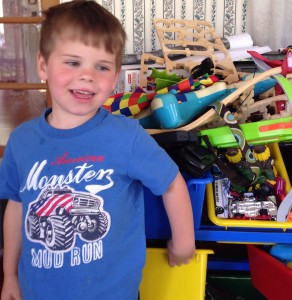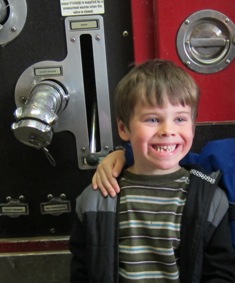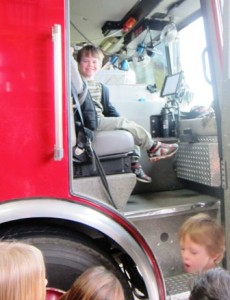Two days before Christmas last month I went to a Walmart store in an unfamiliar neighborhood in hopes of finding Queen’s Greatest Hits for my son (“We Will Rock You” had become his anthem). According to Walmart’s website, it was in stock at this particular store in an area that I did not know. In the past few years, my shopping has mostly been done on-line – no lines, no cranky people, but also no interesting experiences.
This particular Walmart was chaos contained in 50,000 square feet. The parking lot itself was a challenge with people zooming all over, all trying to get the best spot; there was a truck sitting in one of the main lanes not moving, possibly not running, while everyone tried to get around or figure out how to back up. I was driving our big truck because I had to get hay for our animals. I already felt out of place maneuvering this huge vehicle and trying to squeeze myself into a spot at the very end of the lot where I could hopefully get back out again without damaging other cars.
“Get in and get out,” I told myself walking into the store. I sucked in breath as I saw the madness of Walmart near Christmas. The register lines were endless with people of every nationality looking frustrated and stressed, the displays at the front had been damaged from so many people going by, and the chorus of children crying drowned out the bad Christmas music over the speakers.
“Music section, music section,” I directed myself through the throngs of assorted disgruntled shoppers. I had no idea where that would be. My luck usually dictates that it would somewhere completely across the store and I was not disappointed: it was in the very back corner. I finally reached it only to find the CDs in absolutely no recognizable order; if one happened to be in the right alphabetical spot, it was only by chance. And, as I guessed, Queen was nowhere to be found. In fact, there was were nothing in the Q section that started with such a letter. I halfheartedly looked through the surrounding area and the closest I found to classic rock was Poison.
An overweight and bored employee attempting to put CDs in their rightful places asked me if I needed help.”Have you seen any Queen around here?” I asked doubtfully. He laughed as though I asked him if there was a pot of gold at the end of aisle six. I told him that Walmart’s website said that it was in-stock here. This made him laugh harder. He then went on to tell me about an outside website where I could buy an entire MP3 album for $1.50 instead of playing $10 at iTunes. I told him thanks, noted that there was no employee loyalty lurking here, then went to get a gallon of milk so I could get out of this place.
Throughout my adventure in the store the loudspeaker kept announcing that “Giovanni has lost his mom” and would she please come to the front to find him. At first, I was concerned for both parties, being a mom myself I would be distraught if I lost my kid. After the fifth announcement for poor old Giovanni, I started to think that maybe his mom didn’t want to find him. Finding the milk, I politely said “excuse me” to another shopper who was staring into the case. I opened it, got my milk, then held it open for her as I assumed she was getting some too. She looked at me, rolled her eyes, and kept going down the aisle. “OOOkay,” I said to myself, resolving to leave this place and not linger another moment.
I walked up to the registers to find that the chaos had settled somewhat. I found a line that looked promising and watched as a mother and a teenage daughter argued over going back to get something. The girl’s attitude suggested that she was not doing it, but the mother’s bigger attitude prevailed, and the girl went to get whatever missing item they forgot. I noticed that they were next in line but the woman did not look like she was willing to let anyone past, even if that meant she held up the line for the next half hour. “Next line,” I said to myself. I went over one register and found a person trying to buy something with no price and attempting to argue with the cashier over the real price of the item in broken English with no success. Another woman in back of me kept sighing very loudly and saying things to herself about the scene.
This went on for another five minutes. I noticed that Giovanni had finally been reunited with his mom, who had four other children with her and looked like she didn’t care if she had ever found him again. Finally, another cashier opened up and I dashed for it only to find another woman trying to get there faster. As usual, I heeded to the other shopper, not finding it worth the effort to argue over who was there first. To my surprise, she told me that I got there first and to go ahead. “Really? Thanks!” I said looking over at the line where the teenager had still not returned and the people behind the mother getting thoroughly pissed off while the mother looked completely unperturbed, if anything she was seeking a challenger to fight.
The cashier was an older African American woman who was very friendly and helpful, and didn’t seem to mind the Christmas craziness. I paid for my milk and got out of there as fast as I could. The line with the mother and absent teenage girl was starting to get very heated, eyes were starting to bulge and chests heave. “Thank the lord!” I said to myself, dashing to the truck only to find three carts piled up behind it. I got them lined up and moved them to the overflowing cart return, not seeing an employee in sight who would be taking them any time soon.
Getting in my truck, without the CD that I originally sought, I watched as the public transit whizz by, heard horns honking in the distance, and just wanted to leave this store and this place and never come back. I wanted to go home to our very quiet and nature laden neighborhood, where I don’t see another house next to mine, where three cars constitutes a traffic jam, and where animals are more prevalent than people. And I did, after squeezing through the parking lot where the same truck from earlier had not moved; I drove forty-five minutes north east of there, and breathed in the country air, and was glad for it.
Visiting this Walmart in this an unfamiliar neighborhood was good for me, however, because it truly made me appreciate what I have and where I live. I unloaded the hay and was glad for the sweat and effort that it took. I realized that it would be very hard for me to live in an area anywhere near a Walmart, even though I have lived in suburban and somewhat urban areas in the past. We worked hard to get here and it suits me; it would be difficult to live any other place.
It also made me realize that living on five acres in the country is my attempt to hide from reality. In this case, I was trying to hid from Christmas insanity, and it showed me why I should shop ahead and on-line where I deal with no people. But what are the  consequences of that? Besides getting to maintain my sanity, am I depriving my children and myself of seeing other ways of life? Will my kids be unable to handle a chaotic situation surrounded by unfamiliar people one day because I avoid these places?
consequences of that? Besides getting to maintain my sanity, am I depriving my children and myself of seeing other ways of life? Will my kids be unable to handle a chaotic situation surrounded by unfamiliar people one day because I avoid these places?
In truth, I barely take them to any retail store beyond the grocery store because I don’t want to hear about all the things they want. We often avoid retail entirely so they can’t see and don’t know what they don’t have. However, I do think that my way of life “in the country” is a shield from other realities; and I have found that I am not the only one. Most of the people near us live out here for a reason: for some it is their retirement and they want to “get away from it all;” for others, it is wanting their kids to grow up in a place where they can get dirty, and some have just lived here their entire lives and are content with that way of life. Either way, I’ll take my isolation, be glad that I am not Giovanni or his mom, and next year, shop ahead on-line, at least near Christmas time!
 that each hemisphere does have a particular focus, but that creative people are more “right-brained” and “left brained” are more logical is not true. Stating a study that involved reviewing over a thousand MRI brain scans, it was determined there is no greater strength of each hemisphere per individual. Dr. Jandial’s sums it up, “In other words, math geeks and computer programmers use both sides of their brain equally, as do painters and poets.”
that each hemisphere does have a particular focus, but that creative people are more “right-brained” and “left brained” are more logical is not true. Stating a study that involved reviewing over a thousand MRI brain scans, it was determined there is no greater strength of each hemisphere per individual. Dr. Jandial’s sums it up, “In other words, math geeks and computer programmers use both sides of their brain equally, as do painters and poets.” desires is a sure way to discover your inner creative self.” Science backs this up by again studying MRI scans that show connections between different areas of the brain when engaging in day dreaming. He says that creativity requires “a balance between homing in and spacing out, between mastering material and going off on a tangent.” So, go ahead and stare off into space. It’s good for you!
desires is a sure way to discover your inner creative self.” Science backs this up by again studying MRI scans that show connections between different areas of the brain when engaging in day dreaming. He says that creativity requires “a balance between homing in and spacing out, between mastering material and going off on a tangent.” So, go ahead and stare off into space. It’s good for you! mes and free play allow kids to explore all kinds of different worlds and ideas that they wouldn’t necessarily discover while staring at a tablet or going to a structured karate class. And adults can benefit too. Play (in however you define it) allows a freedom that we don’t experience while blindly watching TV or continuously checking email.
mes and free play allow kids to explore all kinds of different worlds and ideas that they wouldn’t necessarily discover while staring at a tablet or going to a structured karate class. And adults can benefit too. Play (in however you define it) allows a freedom that we don’t experience while blindly watching TV or continuously checking email. greater things.”
greater things.”


 (because now he requires an article to sound more important) is pretty dark in almost all aspects, from the actual lack of lighting in the film to the character himself. As someone said, he’s the “emo Batman” with his smudged eye make-up and the lonely, gritty life he leads. A digital production company decided to take the “original” Batman, Adam West, and put him in The Batman’s trailer. They titled it, “The Batman but with the Goofy Batman.” It’s an entertaining watch to see the original Batman in tights with familiar visual sound effects “BAM!” “KAPOW!” etc. in the mean streets of Gotham City. What it made me think about, though, was Batman’s progression from campy entertainment to dark and violent justice. What does this say about what viewers want to see and what filmmakers create? Do we all want the latest version of Batman to be haunted by his past while ruthlessly killing his foes or would we occasionally like to see some ridiculous dancing and ludicrous situations? I vote for men in tights and silly lines, most others (including my brother, a dedicated fan) would vote otherwise. Do a quick search for “Adam West in the Batman” to check it out and see what you think.
(because now he requires an article to sound more important) is pretty dark in almost all aspects, from the actual lack of lighting in the film to the character himself. As someone said, he’s the “emo Batman” with his smudged eye make-up and the lonely, gritty life he leads. A digital production company decided to take the “original” Batman, Adam West, and put him in The Batman’s trailer. They titled it, “The Batman but with the Goofy Batman.” It’s an entertaining watch to see the original Batman in tights with familiar visual sound effects “BAM!” “KAPOW!” etc. in the mean streets of Gotham City. What it made me think about, though, was Batman’s progression from campy entertainment to dark and violent justice. What does this say about what viewers want to see and what filmmakers create? Do we all want the latest version of Batman to be haunted by his past while ruthlessly killing his foes or would we occasionally like to see some ridiculous dancing and ludicrous situations? I vote for men in tights and silly lines, most others (including my brother, a dedicated fan) would vote otherwise. Do a quick search for “Adam West in the Batman” to check it out and see what you think. We recently got chicks (baby chickens, that is) as we do almost every year. What is so incredible about a chick is its instinctual ability to survive almost immediately upon hatching. It begins to peck for food, drink water, and seek out the warmth of the heat lamp from the moment we receive them. They don’t technically need a mother hen (though it is nice for them to have one for the protection) because they inherently know what to do from the very start. Humans, and probably most mammals, don’t have a fighting chance, not from birth anyway. We need the care of someone to survive initially. We have instincts too, of course, but as time goes by, we usually explain those away with our thoughts and emotions. A chick’s simplicity – to eat, drink, sleep, poop, repeat from the very start – is admirable.
We recently got chicks (baby chickens, that is) as we do almost every year. What is so incredible about a chick is its instinctual ability to survive almost immediately upon hatching. It begins to peck for food, drink water, and seek out the warmth of the heat lamp from the moment we receive them. They don’t technically need a mother hen (though it is nice for them to have one for the protection) because they inherently know what to do from the very start. Humans, and probably most mammals, don’t have a fighting chance, not from birth anyway. We need the care of someone to survive initially. We have instincts too, of course, but as time goes by, we usually explain those away with our thoughts and emotions. A chick’s simplicity – to eat, drink, sleep, poop, repeat from the very start – is admirable. As it turns out, the age group that should act the most “adult” – doesn’t. Surprised? Recently, I was listening to a younger podcaster interviewing an even younger food blogger (both considered Instagram “influencers”). They agreed that, when receiving comments/feedback from their posts, TikTok users are the least mean, IG is second, and Facebook and Twitter have the meanest and nastiest commenters. Who typically has accounts to these two outlets? ADULTS. Come on, FB and Twitter adults, grow up and be mature (or maybe that’s not a thing anymore).
As it turns out, the age group that should act the most “adult” – doesn’t. Surprised? Recently, I was listening to a younger podcaster interviewing an even younger food blogger (both considered Instagram “influencers”). They agreed that, when receiving comments/feedback from their posts, TikTok users are the least mean, IG is second, and Facebook and Twitter have the meanest and nastiest commenters. Who typically has accounts to these two outlets? ADULTS. Come on, FB and Twitter adults, grow up and be mature (or maybe that’s not a thing anymore). 90% of them. The other countries are China, France, U.K, Pakistan, India, Israel, and North Korea (that’s in order of the most to the fewest). The more startling fact is that scientists think it would only take about 100 of these nukes to make life on Earth unsustainable (due to air quality, lack of sunlight to grow food, etc). That’s it, 100! And yet, being the ridiculous Earthlings that we are, we have 12,900 more than necessary. Surprising and yet not surprising, no? Let’s hope they stay un-detonated.
90% of them. The other countries are China, France, U.K, Pakistan, India, Israel, and North Korea (that’s in order of the most to the fewest). The more startling fact is that scientists think it would only take about 100 of these nukes to make life on Earth unsustainable (due to air quality, lack of sunlight to grow food, etc). That’s it, 100! And yet, being the ridiculous Earthlings that we are, we have 12,900 more than necessary. Surprising and yet not surprising, no? Let’s hope they stay un-detonated. is pic is my daughter’s running total of the start our COVID “adventure,” when things went funny and we all went into hiding. For her that’s when school ended and distance learning began. (She says it won’t be over until we can go to the movies, still not open yet, and not wear masks.) That was 108 days ago. I dashed her plans of having a “quarantine party” on day 100 though; I told her those two words don’t mix well.
is pic is my daughter’s running total of the start our COVID “adventure,” when things went funny and we all went into hiding. For her that’s when school ended and distance learning began. (She says it won’t be over until we can go to the movies, still not open yet, and not wear masks.) That was 108 days ago. I dashed her plans of having a “quarantine party” on day 100 though; I told her those two words don’t mix well.
 If you had any fun and exciting travel plans this summer, or camps or sports for your kids, you’re probably starting to get the feeling that they’re not going to happen. Just like the spring when, one by one, event after event got nixed, so is the summer. Yes, places are slowly attempting to re-open, but they do so while maintaining difficult, and sometimes impossible, restrictions on the number of people allowed, adequate spacing, and many mask and glove requirements. So even if some of these plans did go forward, they sure wouldn’t be much fun.
If you had any fun and exciting travel plans this summer, or camps or sports for your kids, you’re probably starting to get the feeling that they’re not going to happen. Just like the spring when, one by one, event after event got nixed, so is the summer. Yes, places are slowly attempting to re-open, but they do so while maintaining difficult, and sometimes impossible, restrictions on the number of people allowed, adequate spacing, and many mask and glove requirements. So even if some of these plans did go forward, they sure wouldn’t be much fun. What that might look like, I still don’t have a clear picture of yet, but I told my daughter that we will be visiting lots of places with water in lieu of a pool (and thankfully, we can do that where we live in the middle of nowhere). For those of you who had that great trip planned, the disappointment and the pain of getting refunded is probably extreme, and I am sorry about that. No one wants to continue this way. But, can we find ways to make the best of it? We can wait (which many of us have a hard time doing) until it’s safer to go on that trip (because it really wouldn’t be much fun right now anyway). In the grand scheme of things, so far, we have had two seasons of one year altered from the way we expect them. That’s six months out of the many years that we live. Yes, we can get through it, children and adults too.
What that might look like, I still don’t have a clear picture of yet, but I told my daughter that we will be visiting lots of places with water in lieu of a pool (and thankfully, we can do that where we live in the middle of nowhere). For those of you who had that great trip planned, the disappointment and the pain of getting refunded is probably extreme, and I am sorry about that. No one wants to continue this way. But, can we find ways to make the best of it? We can wait (which many of us have a hard time doing) until it’s safer to go on that trip (because it really wouldn’t be much fun right now anyway). In the grand scheme of things, so far, we have had two seasons of one year altered from the way we expect them. That’s six months out of the many years that we live. Yes, we can get through it, children and adults too.
 consequences of that? Besides getting to maintain my sanity, am I depriving my children and myself of seeing other ways of life? Will my kids be unable to handle a chaotic situation surrounded by unfamiliar people one day because I avoid these places?
consequences of that? Besides getting to maintain my sanity, am I depriving my children and myself of seeing other ways of life? Will my kids be unable to handle a chaotic situation surrounded by unfamiliar people one day because I avoid these places?
 g, and if a movie feels too long then just go for a walk together. Re-connecting by spending alone time with your spouse or partner will improve your relationship, re-establish intimacy, and reinforce the foundation of this family you created together. (You’re both worth it!)
g, and if a movie feels too long then just go for a walk together. Re-connecting by spending alone time with your spouse or partner will improve your relationship, re-establish intimacy, and reinforce the foundation of this family you created together. (You’re both worth it!) rawler then walker then a toddler to a kindergartner and so it goes. It probably feels like light-years away, but it’s not. So when the times are really tough (and having an infant is hard even with an “easy baby”), know that this is all temporary. It will change – you will get to sleep normally again, your world won’t always be consumed by baby concerns, and then once you get used to it, the march of time will slowly transform things yet again. This is good news (to me). Just remember to savor those wonderful moments and breathe through the hard ones!
rawler then walker then a toddler to a kindergartner and so it goes. It probably feels like light-years away, but it’s not. So when the times are really tough (and having an infant is hard even with an “easy baby”), know that this is all temporary. It will change – you will get to sleep normally again, your world won’t always be consumed by baby concerns, and then once you get used to it, the march of time will slowly transform things yet again. This is good news (to me). Just remember to savor those wonderful moments and breathe through the hard ones! much more. Most of the kids were very interested, watching with gleaming eyes. Then we got to the part which the fireman boasted was the most fun – he opened the door to the passenger side of the truck revealing the “Captain’s seat.” He explained that this is a very important seat, and said that all of the cool tools and technology were used in that spot. Then he asked, “would you like to sit in this seat?” Yes!” they all cried excitedly.
much more. Most of the kids were very interested, watching with gleaming eyes. Then we got to the part which the fireman boasted was the most fun – he opened the door to the passenger side of the truck revealing the “Captain’s seat.” He explained that this is a very important seat, and said that all of the cool tools and technology were used in that spot. Then he asked, “would you like to sit in this seat?” Yes!” they all cried excitedly. worst part was that the kids knew exactly what to do – get in the seat, turn to the camera, fake smile, picture taken, get down for the next kid. Only one boy out in the whole group insisted on sitting in the seat and asking questions about everything around him, and he was quickly encouraged to “get down so someone else can have a turn!” A turn at what? I thought. The kids will see their pictures and probably like them, and being five years old they probably won’t remember the field trip too much, but how much more valuable would it have been for them and their little working brains to sit in the Captain’s seat and pretend they really were the captain of the fire truck? Something could have sparked inside one of them as they explored and examined all of the new things they saw there. But instead, we take a picture of the moment and we rush them off for next kid’s photo opp.
worst part was that the kids knew exactly what to do – get in the seat, turn to the camera, fake smile, picture taken, get down for the next kid. Only one boy out in the whole group insisted on sitting in the seat and asking questions about everything around him, and he was quickly encouraged to “get down so someone else can have a turn!” A turn at what? I thought. The kids will see their pictures and probably like them, and being five years old they probably won’t remember the field trip too much, but how much more valuable would it have been for them and their little working brains to sit in the Captain’s seat and pretend they really were the captain of the fire truck? Something could have sparked inside one of them as they explored and examined all of the new things they saw there. But instead, we take a picture of the moment and we rush them off for next kid’s photo opp.